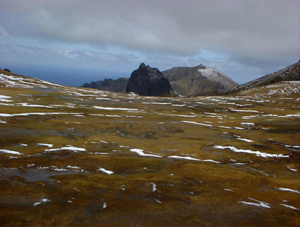Gough Island

View of Gough Island
|
|
| Geography | |
|---|---|
| Location | South Atlantic Ocean |
| Coordinates | 40°19′S 9°56′W / 40.32°S 9.94°WCoordinates: 40°19′S 9°56′W / 40.32°S 9.94°W |
| Archipelago | Tristan da Cunha |
| Area | 91 km2 (35 sq mi) |
| Length | 13 km (8.1 mi) |
| Width | 7 km (4.3 mi) |
| Highest elevation | 910 m (2,990 ft) |
| Highest point | Edinburgh Peak |
| Administration | |
|
United Kingdom
|
|
| St Helena, Ascension and Tristan da Cunha | |
Gough Island /ˈɡɒf/, also known historically as Gonçalo Álvares (after the Portuguese explorer) or mistakenly as Diego Alvarez, is a volcanic island in the South Atlantic Ocean. It is a dependency of Tristan da Cunha and part of the British overseas territory of Saint Helena, Ascension and Tristan da Cunha. It is uninhabited except for the personnel of a weather station (usually six people) which the South African National Antarctic Programme has maintained continually on the island since 1956. It is one of the most remote places with a constant human presence.
Gough Island and Inaccessible Island comprise the UNESCO World Heritage Site of Gough and Inaccessible Islands.
The island was first named Ilha de Gonçalo Álvares on Portuguese maps. It was named Gough Island after Captain Charles Gough of the Richmond who sighted the island in 1732. Confusion of the unusual Portuguese saint name Gonçalo with Spanish Diego led to the misnomer "Diego Alvarez island" in English sources from the 1800s to 1930s. However, the most likely explanation is that it was simply a misreading of 'Is de Go Alvarez', the name by which the island is represented on some of the early charts, the 'de Go' mutating into 'Diego'.
The details of the discovery of Gough Island are unclear, but the most likely occasion is July 1505 by the Portuguese explorer Gonçalo Álvares. Maps during the next three centuries named the island after him. On some later maps, this was erroneously given as Diego Alvarez. According to some historians, the English merchant Anthony de la Roché was the first to land on the island, in the austral autumn of 1675.
...
Wikipedia

